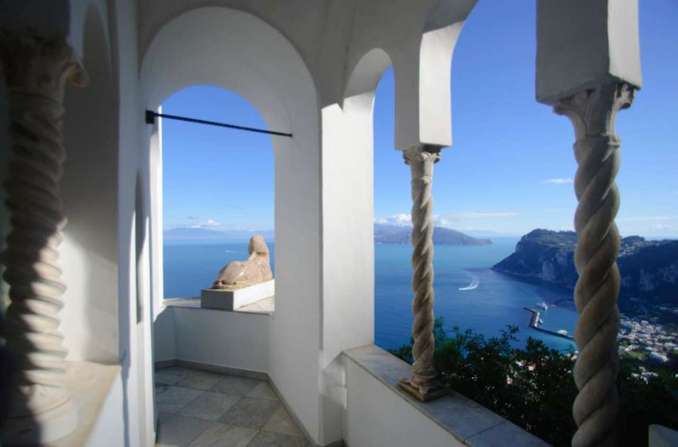
23 June 2017
Villa San Michele
Villa San Michele is not a residence in the ordinary sense of the word. It is rather the bearer of Axel Munthe's thoughts and feelings about beauty and the great questions of life, but at the same time it is open for personal interpretation. The architecture is there to emphasise the magnificence of the landscape whilst also creating a romantic-symbolic spirit and a worthy framework for the works of art. In this respect the park also plays an important role. Typical elements include the statues overgrown with ivy and the mossy marble pieces scattered around the garden.
The number of objects in marble, stone, mosaic, and terracotta total about 650. There are about 530 objects in wood, metal, ceramics and textiles. The collections can be divided into several main themes, such as images of nature and animals, as well as death and dying. But they are in no way exhibited pragmatically. Rather, they consist of apparently haphazardly assembled pieces of widely differing quality.
Regardless of an individual object's artistic quality, what was important to Axel Munthe was the message it conveyed or the personal memories it evoked for him. This observation is strengthened by the fact that the collections do not contain items acquired in groups from other collections.
The garden at Villa San Michele lies on a plateau about 300 metres above the sea with a view across the Bay of Naples and the Sorrentine Peninsula with the volcano Mount Vesuvius in the distance. When the weather is clear the island of Ischia can be detected to the north. The garden is not large but is rich in content and variety in terms of both its levels and colours.
The garden still mostly follows Munthe's intentions. Visitors leave the villa via the colonnade, which becomes a pergola, which in its turn is succeeded by terraces, viewpoints and open areas or more secluded nooks.
A spectrum of brightly coloured plants adds life and colour in contrast to the muted vegetation of cypresses, thuja, ivy, box and mosses. The unroofed colonnade is covered by a wooden trellis across which wisteria spreads out its knobbly branches.
Everywhere pots, amphorae and various art objects have been placed out. Flowers successively come into bloom – camellias, flowering ash, azaleas, wisteria, hydrangeas, roses, agapanthus, busy Lizzie and hundreds of other plants from the Mediterranean region and other parts of the world. The indigenous wild flowers include acanthus, myrtle, broom, rock rose and many others.
The predominant tall tree species are the stone pine, palm and cypress. Thanks to its location and character, the garden remains fresh and green all year round. During the hottest period of summer, shady arbours and airy resting places offer cooler temperatures to the visitor.
(If you want, share your garden stories by sending an email to media@grandigiardini.it)
The number of objects in marble, stone, mosaic, and terracotta total about 650. There are about 530 objects in wood, metal, ceramics and textiles. The collections can be divided into several main themes, such as images of nature and animals, as well as death and dying. But they are in no way exhibited pragmatically. Rather, they consist of apparently haphazardly assembled pieces of widely differing quality.
Regardless of an individual object's artistic quality, what was important to Axel Munthe was the message it conveyed or the personal memories it evoked for him. This observation is strengthened by the fact that the collections do not contain items acquired in groups from other collections.
The garden at Villa San Michele lies on a plateau about 300 metres above the sea with a view across the Bay of Naples and the Sorrentine Peninsula with the volcano Mount Vesuvius in the distance. When the weather is clear the island of Ischia can be detected to the north. The garden is not large but is rich in content and variety in terms of both its levels and colours.
The garden still mostly follows Munthe's intentions. Visitors leave the villa via the colonnade, which becomes a pergola, which in its turn is succeeded by terraces, viewpoints and open areas or more secluded nooks.
A spectrum of brightly coloured plants adds life and colour in contrast to the muted vegetation of cypresses, thuja, ivy, box and mosses. The unroofed colonnade is covered by a wooden trellis across which wisteria spreads out its knobbly branches.
Everywhere pots, amphorae and various art objects have been placed out. Flowers successively come into bloom – camellias, flowering ash, azaleas, wisteria, hydrangeas, roses, agapanthus, busy Lizzie and hundreds of other plants from the Mediterranean region and other parts of the world. The indigenous wild flowers include acanthus, myrtle, broom, rock rose and many others.
The predominant tall tree species are the stone pine, palm and cypress. Thanks to its location and character, the garden remains fresh and green all year round. During the hottest period of summer, shady arbours and airy resting places offer cooler temperatures to the visitor.
(If you want, share your garden stories by sending an email to media@grandigiardini.it)
If you have a garden and a library, you have everything you need- Cicerone - |






